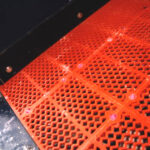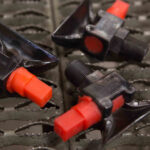
5 Tips for Maximizing Screen Efficiency
January 12, 2021
Top 4 Reasons Polydeck Spray Nozzles Are Leading The Industry
January 12, 2021We’ve put together a list of must-have safety checks for you and your employees when it comes to your screen media systems – read more today.
Safety of employees is top-of-mind for many plant managers and executives out there, and rightly so. In our industry, there is a potential for many workplace injuries, with heavy machinery and lots of moving parts. With this in mind, we’ve put together a list of must-have safety checks for you and your employees when it comes to your screen media systems. Read on to learn how more about workplace safety, as well as how to maximize the use of your screen media systems (safely, that is!).
1) Lock, Tag & TRY
If you’re performing any work on your screens, lock them out, along with their feed and discharge conveyors. It’s key to try the start button after locking out, to make sure you’ve got the right units. If you’re not sure where to lock out, there’s usually a plant diagram in the electrical room, or someone happy to show you how well they know the plant to help!
2) Keep it Quiet
Forget about wire or punch plate on your screens, this stuff operates at around 105dB! Switching to synthetic will reduce this to around 95dB. You might be thinking that’s just a reduction of 10dB, but decibels are a logarithmic scale, meaning each increase of +1db is a x10 multiplier. In brief, the difference between 105dB and 95dB is about half of what the human ear perceives. This will contribute to screen media safety with less risk of hearing loss and much better perception/awareness of what else is going on around the plant.
3) Lighten Up
Changing punch plate or wire cloth can be quite the task. It’s large, heavy and unruly to handle. If you haven’t done it before, think of moving a 4’ x 8’ section of sharp, heavy, floppy metal inches from the edge of a machine while balancing on ½” wide rails with openings below (eeek!). Unless you’re a heavy-lifting ballerina, it’s truly no fun. Consider modular media for a minute, which comes in 1×1’ and 1×2’ sections, for example. One person can change a localized area, away from fall hazards, without creating large open spaces to fall through beneath.
4) Make it Last
It’s no secret, changing screens isn’t fun, so why do it any more frequently than necessary? One reason is for screen media safety! Make sure you’re using as long-lasting screen media as possible as your throughput will allow. Place heavy duty media in your impact zones, and lighter formats in your flow path. This will even out the longest lasting options along your media screen’s surface and drastically reduce your workload, and exposure to any maintenance hazards. No matter what screen media you use, there are options for heavy duty to light duty formats to balance wear with open area / throughput. That said, synthetic media lasts 12-20x longer than wire will.
5) Keep Cool
Fire hazards are very real around screens. Gum rubber chute liners and cast-in-place media/liners (like spray bar boots and most magnetic liners) are highly susceptible to starting a fire. While all synthetics will burn when continuously exposed to flames, there are many options out there that reduce the risk of a fire and ensure screen media safety. Injection molded media will frequently allow a piece of hot steel to simply drop through for example, whereas cast-in-place media or gum rubber liners tend to spread fire rapidly. Some aggregate producers have entirely banned cast-in-place synthetics and gum rubber liners! If you’re doing hot work around synthetics, make sure your fire watch includes someone who can see below the work, and not just the workers above who are likely focused on their immediate point of work.
6) Dust It Off
Keeping the dust down is important to the safety of site staff and neighbors. Dust can easily blind up your screens. There’s a multitude of wire and synthetic choices out there to handle wet, sticky material on your screens. Using the right screen media to deal with blinding from dust suppression ensures you’re not sending staff into screens for nasty clean up jobs as a result of trying to improve their screen media safety in the first place!
7) Make It Simple
Make your screens simple and easy to deal with. This will ensure that when it is time to work on them, it’s likely to get done quicker and more accurately. Simplifying your screens with modular media also allows you to focus on higher priority tasks like plant automation, optimization, and better mine planning. Stop changing cumbersome screens and move on to something more fun entirely!
Go ahead, put these screen media safety tips into practice! In the meantime, if you want to learn more about Polydeck screens or any of our other products, contact us today!
Written by Alex Caruana, Aggregate Territory Manager for Polydeck.